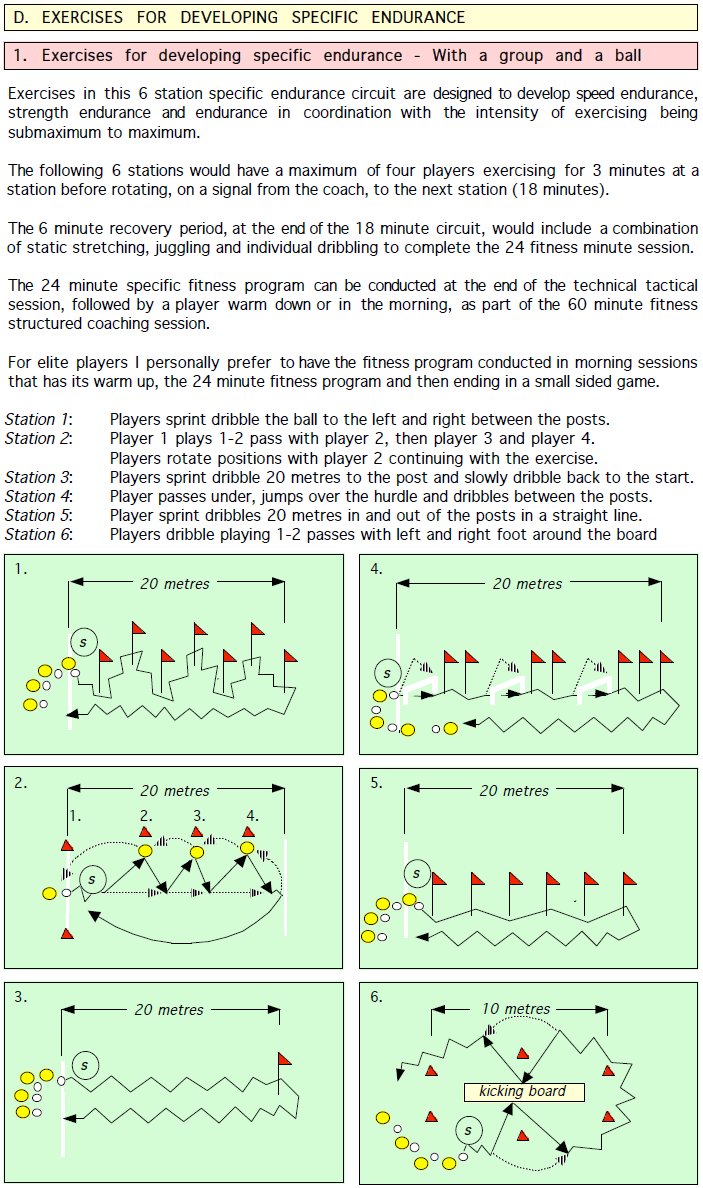
Specific Endurance
Coaching with

Endurance
 Football endurance could be described as exercising an enduring activity under specific
Football endurance could be described as exercising an enduring activity under specific
conditions without reduced efficiency. Expressed in simple training terms, endurance is an ability to ‘keep on going’. A heart rate monitor is very useful tool to have to keep track of the players heart rate during endurance training.
The maximum heart rate can be estimated by subtracting the players age from 220 using the
following formula:
220 – player age = maximum heart rate.
From the above, a 20 year old footballers maximum heart rate would be 200 beats per minute.
Maximum heart rate = 220 – 20 years = 200 (beats per minute)
Minimum target heart rate = 200 x 0.70 = 140 (beats per minute)
Maximum target heart rate = 200 x 0.85 = 170 (beats per minute)
If for example, the 20 year old footballers wanted to improve their aerobic endurance fitness
they would need to work out their maximum heart rate times 70 and 85 per cent to target their endurance training zone.
As a result, the 20 year old player would need to run continuously, with or without the ball, for a minimum of 20 minutes with a heart rate between 140 – 170 beats per minute for the session to have any aerobic training effect. Decades ago the superstars were covering 3,000 to 4,000 metres in a game while today it is above 11,000 metres. So fitness in football has made and is still making progress. Football endurance can be divided into basic, speed, strength and specific endurance.
Basic Endurance
Basic football endurance endurance can be defined as the ability of the player to perform an enduring physical activity at low intensity. Basic endurance is also called aerobic endurance.
Any training activity that keeps the heart rate constantly elevated to 70-85 per cent of maximum heart rate is called aerobic.
Speed Endurance
Speed endurance is the ability of the footballer to perform an enduring physical activity of different speed characteristics without reducing player effectiveness. Speed endurance is also called anaerobic endurance. It is the ability to sustain high-intensity efforts, where energy is supplied anaerobically. Anaerobic movements are much higher in intensity, 85 per cent of maximum heart rate, and require energy quickly and therefore do not allow the body to break down carbohydrates completely.
As a result of this anaerobic exercising cannot be sustained for long periods of time. A simple test for the coach to see if players are exercising anaerobically is the talk test. If players are having a conversation while exercising they are working aerobically, while if it is too difficult for them to talk, they are working anaerobically.
Strength Endurance
Strength endurance of the footballer is the capacity to exert a force repeatedly over an extended time. It is not possible to definitively state the precise repetition range that will lead to specific muscular endurance, however the general recommendations are that high repetitions will build endurance and low repetitions will build strength.
Specific Endurance
Specific endurance is the ability of the player to perform an enduring physical activity of specific nature without reducing effectiveness. It allows a player to change speed easily throughout the entire game and execute extremely intense movements such as sprinting with or without the ball, jumping to head the ball, speed in change of direction and at the same time maintaining a high level of quality work.
An example where a team needs to have a high level of specific endurance is when players go on a press or move in shallow formations in attack or defence. In the modern game basic, speed, strength and specific endurance all play a vital role in the success of the player and team.
Factors that influence Endurance
Footballers usually reach their peak in endurance between the age of 27 to 30 years.
Both the aerobic and anaerobic endurance capacity are influenced by genetic factors such as age, gender and heredity.
This endurance capacity is also influenced by other factors such as environmental, training techniques and principles of training.A footballers basic endurance or aerobic capacity will depends on effective respiration, effective oxygen transport and effective use of oxygen within the cell.
A players lifestyle will also have a positive effect on endurance, which would includes having sufficient sleep or rest, a balanced diet that would include fruits,vegetables, lean meat and plenty of water. A highly motivated and determined player will also positively influence the development of endurance while a player not motivated will have a negative effect.
Developing Endurance
Just running laps in endurance training is not football specific and can become very boring.
As a result various patterns of running with and without the ball should be introduced at endurance training sessions to break the monotony and to make the sessions more interesting.
In my opinion, only from the age of 13, coaches should implement specific endurance and other fitness training sessions in the youth development program. Emphasis in the earlier ages of development should be on technical and basic tactical development with no specific fitness or endurance training sessions. Since training games are the main focus of practice it makes sense to use them for endurance training in the lower age groups.
Developing endurance in footballers can be divided into the following:
A. Exercises for developing aerobic endurance
B. Exercises for developing aerobic/anaerobic endurance
C. Exercises for developing anaerobic endurance
D. Exercises for developing specific endurance
The following is an example for developing specific endurance:




